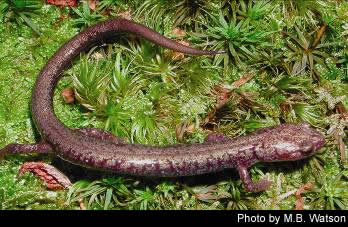

WILDLIFE DIVERSITY NOTEBOOK: Cheat Mountain Salamander Common Name: Cheat Mountain Salamander Scientific Name: Plethodon nettingi Status: The Cheat Mountain salamander has been listed by the U.S. Fish and Wildlife Service as threatened throughout its range since 1989. West Virginia Status: The Cheat Mountain salamander is one of 30 species of salamanders known to occur in West Virginia. It was discovered by Graham Netting and Leonard Llewellyn on White Top Mountain, Randolph County in 1935 and was described (named) by N. Bayard Green in 1938. There are over 70 known sites for this species in the mountainous areas of Tucker, Grant, Randolph, Pendleton and Pocahontas counties. Description: The Cheat Mountain salamander belongs to a group known as the woodland salamanders (Plethodontids). There are generally two sizes of woodland salamanders, large and small. Large species include the slimy salamander and Wehrle's salamander. The Cheat Mountain salamander is one of the small woodland species attaining a length of 4 inches from the tip of the snout to the tip of the tail. It is black or dark brown with brassy or silvery flecks above and uniformly dark gray beneath. The tail of this species is about the same length as its body, and the body has 17 to 19 costal grooves (vertical grooves along its sides). Habitat: Originally, the Cheat Mountain salamander was probably restricted to the red spruce forests of West Virginia's higher mountains. Since most of these forests were cut by 1920, several populations today occur in mixed deciduous forests that have replaced red spruce stands; these forests include yellow birch, American beech, sugar maple, striped maple and Eastern hemlock trees. Typically, this species is found in cool, moist red spruce forests with a ground cover comprised of a liverwort called Bazzania and an abundance of leaf litter, fallen logs and sticks. Threats And Prospects: The main threat to the Cheat Mountain salamander is degradation of high-elevation red spruce and spruce/northern hardwood forests. Any disturbance exposing the forest floor to sunlight changes the cool, moist conditions on which these animals depend for nest sites as well as food and oxygen procurement. Alterations as minor as clearing service roads or hiking trails can fragment and isolate populations as these salamanders do not cross bare surfaces. As populations become divided their gene pools decline and so do their chances of remaining viable. Scientists have speculated that habitat alterations may favor the encroachment of mountain dusky and redback salamanders which subsequently out-compete the Cheat Mountain salamander for food, cover and moist spots. The Cheat Mountain salamander has been protected under the Federal Endangered Species Act since 1989. Furthermore, much of its range falls within the Monongahela National Forest which seeks to protect the habitat of this and other rare animals. Annual surveys by Marshall University's Dr. Thomas Pauley, a renowned expert on this species, indicate that its numbers appear to be stable except where habitats have been altered. With continued discretion in the management of high-elevation spruce and associated hardwood forests, the future of the Cheat Mountain salamander looks sound. Range: Some woodland salamanders have very large ranges. For example, the redback salamander extends throughout most of the northeastern United States including West Virginia. The Cheat Mountain salamander, however, is endemic to West Virginia (it occurs in the Mountain State and nowhere else). It is the only described vertebrate species in the state that is found entirely within West Virginia. The entire range of this species is 935 square miles, the approximate area of Kanawha County. Within this area there exist many disjunct populations, meaning they are not in contact with each other. This salamander occurs in the high mountains of east central West Virginia from Backbone Mountain, Tucker County in the north to Thorny Flat, Pocahontas County in the south. It is generally found above 3,500 feet, however in the northern part of its range it extends down to 2,640 feet. Life History: Cheat Mountain salamanders spend the winter underground where temperatures remain above freezing. When the weather warms up, usually around May, these salamanders emerge from underground. The female typically lays 8 to 10 eggs which are attached to the inside of a rotten log or the underside of a rock or log. The female guards the eggs until they hatch, a behavior unique to salamanders of the family Plethodontidae. The young undergo their larval stage within the egg so that they resemble small adults when they hatch in late August or September. The juveniles reach sexual maturity in 3-4 years and live for approximately 20 years. The young may remain in the same area as the adults until they become mature at which time they move away and establish territories. Territories are about 48 square feet in area. Woodland salamanders seldom leave their territories and, as a result, move only a few meters during their lives. Like all amphibians, salamanders lack an external covering of scales, hair, or feathers. Instead their skin is slimy and must stay moist. Lungless salamanders, such as the Cheat Mountain salamander, breathe through their skin and the lining of their mouths and therefore require a habitat that is moist and cool. Diet : Like all woodland salamanders, the Cheat Mountain salamander preys on small insects and other invertebrates including mites, springtails, beetles, flies and ants. On moist evenings it searches the forest floor, rocks and logs for food. It will occasionally climb trees, shrubs and stumps in pursuit of food. Compiled by the DNR Wildlife Diversity Staff. |
